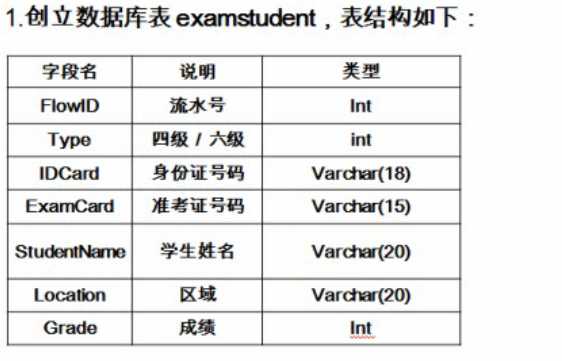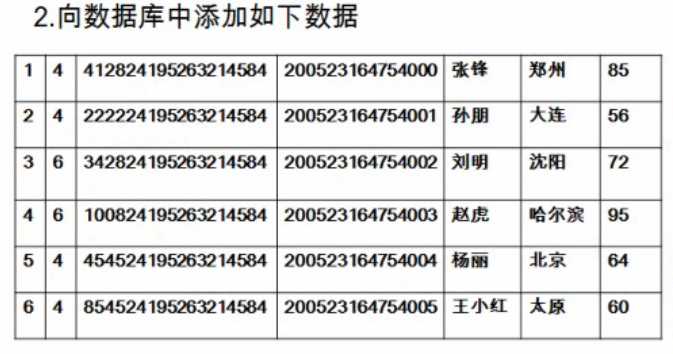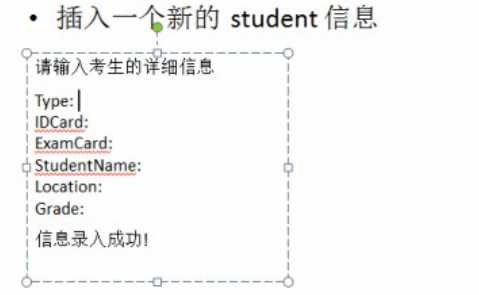标签:
复习和练习
复习部分
一、获取数据库连接
1)方式一
1 // 获取数据库连接 2 @Test 3 public void testGetConnection() throws Exception { 4 // 1.准备获取连接的四个字符串:user,jdbcurl,password,driverClass 5 String user = "root"; 6 String password = "123456"; 7 String jdbcUrl = "jdbc:mysql://localhost:3306/atguigu"; 8 String driverClass = "com.mysql.jdbc.Driver"; 9 Class.forName(driverClass); 10 Connection connection = DriverManager.getConnection(jdbcUrl, user, 11 password); 12 System.out.println(connection); 13 }
2)方式二:解耦合
1 public Connection getConnection() throws IOException, 2 ClassNotFoundException, SQLException { 3 Properties properties = new Properties(); 4 InputStream inputStream = JDBCTest.class.getClassLoader() 5 .getResourceAsStream("jdbc.properties"); 6 properties.load(inputStream); 7 String user = properties.getProperty("user"); 8 String password = properties.getProperty("password"); 9 String jdbcUrl = properties.getProperty("jdbcUrl"); 10 String driverClass = properties.getProperty("driver"); 11 Class.forName(driverClass); 12 Connection connection = DriverManager.getConnection(jdbcUrl, user, 13 password); 14 return connection; 15 }
二、Statement执行更新数据的操作
我们这里把更新数据的操作。用一个通用的update函数来表示
1 public void update() { 2 // 1.获取数据库连接 3 Connection connection = null; 4 Statement statement = null; 5 try { 6 connection=getConnection(); 7 // 2.调用Connection对象的createStatement()方法获取 8 // Statement对象 9 statement=connection.createStatement(); 10 // 3.准备SQL语句 11 String sql="insert into examstudent values(1,4,‘412824195263214584‘,‘200523164754000‘,‘张峰‘,‘郑州‘,85)"; 12 // 4.发送SQL语句:调用Statement对象的excuteUpdate(sql)方法 13 statement.executeUpdate(sql); 14 15 } catch (Exception e) { 16 e.printStackTrace(); 17 }finally{ 18 // 5.关闭数据库资源:由里向外关闭 19 releaseDB(null, statement, connection); 20 } 21 }
三、ResultSet执行查询操作
1 @Test 2 public void testResultSet(){ 3 Connection connection=null; 4 Statement statement=null; 5 ResultSet resultSet=null; 6 try { 7 //1.获取数据库连接 8 connection=getConnection(); 9 //2.Statement 10 statement=connection.createStatement(); 11 //3.准备SQL 12 String sql="select * from customers"; 13 //4.执行SQL,得到结果集 14 resultSet=statement.executeQuery(sql); 15 //5.处理结果集 16 while(resultSet.next()){ 17 int id=resultSet.getInt(1); 18 String name=resultSet.getString(2); 19 String email=resultSet.getString(3); 20 Date birth=resultSet.getDate(4); 21 System.out.println(id); 22 System.out.println(name); 23 System.out.println(email); 24 System.out.println(birth); 25 System.out.println("----------"); 26 } 27 28 } catch (Exception e) { 29 e.printStackTrace(); 30 }finally{ 31 releaseDB(resultSet, statement, connection); 32 } 33 }
四、工具类的使用JDBCTools
将获取连接、执行更新操作、释放资源封装在一个JDBCTools类中
1 package com.atguigu.jdbc; 2 3 import java.io.IOException; 4 import java.io.InputStream; 5 import java.sql.Connection; 6 import java.sql.DriverManager; 7 import java.sql.ResultSet; 8 import java.sql.SQLException; 9 import java.sql.Statement; 10 import java.util.Properties; 11 12 public class JDBCTools { 13 // 更新的方法:插入、删除、更新,但是不包含select 14 public static void update(String sql) { 15 // 1.获取数据库连接 16 Connection connection = null; 17 Statement statement = null; 18 try { 19 connection = getConnection(); 20 // 2.调用Connection对象的createStatement()方法获取 21 // Statement对象 22 statement = connection.createStatement(); 23 // 4.发送SQL语句:调用Statement对象的excuteUpdate(sql)方法 24 statement.executeUpdate(sql); 25 26 } catch (Exception e) { 27 e.printStackTrace(); 28 } finally { 29 // 5.关闭数据库资源:由里向外关闭 30 release(null, statement, connection); 31 } 32 } 33 34 // 获取数据库连接 35 public static Connection getConnection() throws IOException, 36 ClassNotFoundException, SQLException { 37 Properties properties = new Properties(); 38 InputStream inputStream = JDBCTest.class.getClassLoader() 39 .getResourceAsStream("jdbc.properties"); 40 properties.load(inputStream); 41 String user = properties.getProperty("user"); 42 String password = properties.getProperty("password"); 43 String jdbcUrl = properties.getProperty("jdbcUrl"); 44 String driverClass = properties.getProperty("driver"); 45 Class.forName(driverClass); 46 Connection connection = DriverManager.getConnection(jdbcUrl, user, 47 password); 48 return connection; 49 } 50 51 // 释放数据库资源 52 public static void release(ResultSet rs, Statement statement, 53 Connection conn) { 54 if (rs != null) { 55 try { 56 rs.close(); 57 } catch (Exception e) { 58 // TODO: handle exception 59 } 60 } 61 if (statement != null) { 62 try { 63 statement.close(); 64 65 } catch (Exception e2) { 66 // TODO: handle exception 67 } 68 } 69 if (conn != null) { 70 try { 71 conn.close(); 72 } catch (SQLException e) { 73 e.printStackTrace(); 74 } 75 } 76 } 77 }
练习部分
我们的练习是这样的:
新建一个表:

向表中插入数据:

插入成功的话会出现这样的提示(我们从控制台获取要插入的数据):

第一步、用图形化界面SQLyog创建一个数据表examstudent

第二步、向数据表中插入数据
面向对象的思想去编程:将插入的数据封装在一个类Student中

1 package com.atguigu.jdbc; 2 3 public class Student { 4 // 流水号 5 private int flowId; 6 // 考试类型 7 private int type; 8 // 身份证号 9 private String idCard; 10 // 准考证号 11 private String examCard; 12 // 学生姓名 13 private String studentName; 14 // 学生地址 15 private String location; 16 // 考试成绩 17 private int grade; 18 19 public int getFlowId() { 20 return flowId; 21 } 22 23 public void setFlowId(int flowId) { 24 this.flowId = flowId; 25 } 26 27 public int getType() { 28 return type; 29 } 30 31 public void setType(int type) { 32 this.type = type; 33 } 34 35 public String getIdCard() { 36 return idCard; 37 } 38 39 public void setIdCard(String idCard) { 40 this.idCard = idCard; 41 } 42 43 public String getExamCard() { 44 return examCard; 45 } 46 47 public void setExamCard(String examCard) { 48 this.examCard = examCard; 49 } 50 51 public String getStudentName() { 52 return studentName; 53 } 54 55 public void setStudentName(String studentName) { 56 this.studentName = studentName; 57 } 58 59 public String getLocation() { 60 return location; 61 } 62 63 public void setLocation(String location) { 64 this.location = location; 65 } 66 67 public int getGrade() { 68 return grade; 69 } 70 71 public void setGrade(int grade) { 72 this.grade = grade; 73 } 74 75 public Student(int flowId, int type, String idCard, String examCard, 76 String studentName, String location, int grade) { 77 super(); 78 this.flowId = flowId; 79 this.type = type; 80 this.idCard = idCard; 81 this.examCard = examCard; 82 this.studentName = studentName; 83 this.location = location; 84 this.grade = grade; 85 } 86 87 public Student() { 88 89 } 90 91 // 重写Student对象的toString函数 92 @Override 93 public String toString() { 94 return "Student [flowId=" + flowId + ", type=" + type + ", idCard=" 95 + idCard + ", examCard=" + examCard + ", studentName=" 96 + studentName + ", location=" + location + ", grade=" + grade 97 + "]"; 98 } 99 100 }
从控制台获取输入信息作为插入student对象的相应的字段值,并插入到新创建的表中

1 package com.atguigu.jdbc; 2 3 import java.util.Scanner; 4 5 import org.junit.Test; 6 7 public class JDBCTestCase { 8 9 //单元测试 10 @Test 11 public void testAddNewStudent() { 12 Student student = getStudentFromConsole(); 13 addNewStudent(student); 14 } 15 16 // 从控制台输入学生的信息 17 private Student getStudentFromConsole() { 18 Scanner scanner = new Scanner(System.in); 19 Student student = new Student(); 20 System.out.print("FlowId:"); 21 student.setFlowId(scanner.nextInt()); 22 System.out.print("Type:"); 23 student.setType(scanner.nextInt()); 24 System.out.print("IdCard:"); 25 student.setIdCard(scanner.next()); 26 System.out.print("ExamCard:"); 27 student.setExamCard(scanner.next()); 28 System.out.print("StudentName:"); 29 student.setStudentName(scanner.next()); 30 System.out.print("Location:"); 31 student.setLocation(scanner.next()); 32 System.out.print("Grade:"); 33 student.setGrade(scanner.nextInt()); 34 return student; 35 } 36 37 public void addNewStudent(Student student) { 38 String sql = "insert into examstudent" + " values(" 39 + student.getFlowId() + "," + student.getType() + ",‘" 40 + student.getIdCard() + "‘,‘" + student.getExamCard() + "‘,‘" 41 + student.getStudentName() + "‘,‘" + student.getLocation() 42 + "‘," + student.getGrade() + ")"; 43 System.out.println(sql); 44 JDBCTools.update(sql); 45 } 46 47 }
第三步、进行数据的查询(按第三张图片中要求的形式进行查询)
1).从控制台输入一个整数,确定要查询的类型
1 /* 2 * 1.身份证查询。 2.用准考证查询 。 3,其他,重新输入 3 */ 4 private int getSearchTypeFromConsole() { 5 System.out.println("请输入查询类型:1.身份证查询. 2.用准考证查询 "); 6 Scanner scanner = new Scanner(System.in); 7 int type = scanner.nextInt(); 8 if (type != 1 && type != 2) { 9 System.out.println("输入有误,请重新输入!"); 10 throw new RuntimeException(); 11 } 12 return 0; 13 }
2).根据查询类型准备sql语句
1 // searchType:1或者2 2 private Student searchStudent(int searchType) { 3 String sql = "select * from examstudent where "; 4 Scanner scanner = new Scanner(System.in); 5 // 1.根据输入的searchType,提示用户输入信息 6 // 1.1若searchType=1,提示:请输入身份证号 7 // 1.2若searchType=2,提示:请输入准考证号 8 // 2/根据searchType确定SQL 9 if (searchType == 1) { 10 System.out.print("请输入准考证号:"); 11 String examCard = scanner.next(); 12 sql = sql + "examCard=‘" + examCard + "‘"; 13 } else { 14 System.out.print("请输入身份证号:"); 15 String IdCard = scanner.next(); 16 sql = sql + "IdCard=‘" + IdCard + "‘"; 17 } 18 19 // 3.执行查询 20 Student student = getStudent(sql); 21 // 4.若存在结果,将查询结果封装成一个Student对象 22 return student; 23 }
执行查询操作,将结果封装成一个Student对象
1 private Student getStudent(String sql) { 2 Student student = null; 3 Connection connection = null; 4 Statement statement = null; 5 ResultSet resultSet = null; 6 try { 7 connection = JDBCTools.getConnection(); 8 statement = connection.createStatement(); 9 resultSet = statement.executeQuery(sql); 10 if (resultSet.next()) { 11 student = new Student(resultSet.getInt(1), resultSet.getInt(2), 12 resultSet.getString(3), resultSet.getString(4), 13 resultSet.getString(5), resultSet.getString(6), 14 resultSet.getInt(7)); 15 } 16 } catch (Exception e) { 17 e.printStackTrace(); 18 } finally { 19 JDBCTools.release(resultSet, statement, connection); 20 } 21 return student; 22 }
打印查询结果:
1 /** 2 * 打印学生信息:若学生存在则打印具体信息,否则打印:查无此人 3 */ 4 private void printStudent(Student student) { 5 if (student != null) { 6 System.out.println(student); 7 } else { 8 System.out.println("查无此人"); 9 } 10 }
写一个测试方法测试一下:
1 @Test 2 public void testGetStudent() { 3 // 1.得到查询的类型 4 int searchType = getSearchTypeFromConsole(); 5 // 2.具体查询信息 6 Student student = searchStudent(searchType); 7 // 3.打印学生信息 8 printStudent(student); 9 }
运行结果:
请输入查询类型:1.身份证查询. 2.用准考证查询 1 请输入身份证号:3 Student [flowId=1, type=2, idCard=3, examCard=4, studentName=lili, location=dalin, grade=85]
标签:
原文地址:http://www.cnblogs.com/ysw-go/p/5456396.html